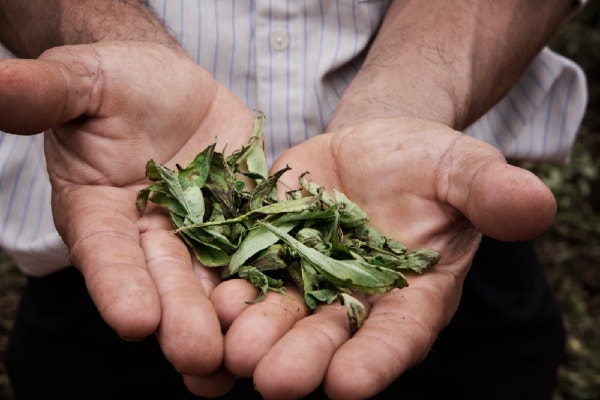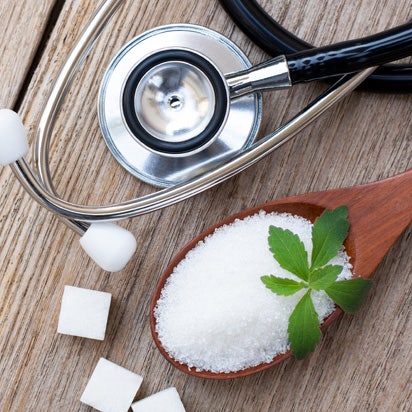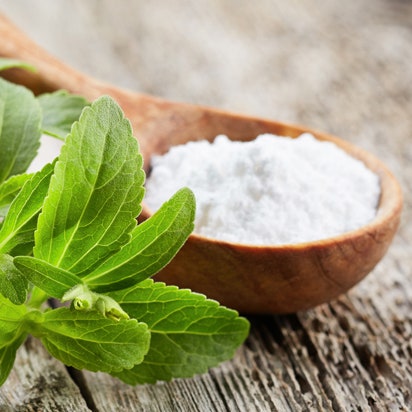
Stevia safety

Stevia is safe for human consumption
High-purity stevia leaf extracts are used as plant-based, zero-calorie sweetening ingredients around the world. These extracts, chemically known as steviol glycosides, have been rigorously tested in over 200 peer-reviewed published research studies and deemed safe for human consumption. Regulatory agencies around the world have also concluded that high-purity stevia leaf extract is safe for use as a sweetener for the general population.
In 2008 and 2009 respectively, the United States Food and Drug Administration (FDA) and the Food and Agriculture Organization/World Health Organization’s Joint Expert Committee on Food Additives (JECFA), a global panel of food ingredient safety experts, approved high-purity steviol glycosides for human consumption as a non-medical ingredient and developed an Acceptable Daily Intake (ADI).
Acceptable daily intake
The Acceptable Daily Intake (ADI) is the amount of a substance that people can consume in food or beverages on a daily basis over the course of their entire life without any appreciable risk to health. The ADI set for steviol glycosides is expressed as steviol equivalents of 4 milligrams per kilogram of body weight per day. This equates to approximately 12 mg of high-purity stevia extracts per kilogram of body weight per day.
To put the ADI for high-purity stevia glycosides into perspective, a 150-pound (70 kg) person would need to consume approximately 40 packets of a tabletop stevia sweetener per day for the rest of their life to reach the ADI. The ADI was established using a safety factor of 100, which includes a 10 times factor to account for potential differences between humans and animal species used in toxicological testing, and a 10 times factor to account for potential differences within the human population, such as between children and adults.
Thus, any potential increased susceptibility of children compared to adults to steviol glycosides has been proactively addressed in the establishment of the ADI. Also, it is important to note that some of the studies used to establish the ADI demonstrated that daily doses of steviol glycosides as high as 1,000 milligrams per person per day were well-tolerated by both healthy people with normal glucose metabolism and those with Type 2 diabetes.

Whole stevia leaf and crude extract are not the same as high-purity stevia leaf extract
Traditionally, stevia leaves were dried and used to sweeten tea and medicines. Today, crude stevia extracts are still sold as dietary supplements in some countries; however, it is only the high-purity stevia leaf extract form of stevia that has been evaluated and approved for use as an ingredient in food and beverages by the world’s leading regulatory agencies. For an in-depth review of stevia safety, see the European Foods Safety Authority Scientific Opinion on the safety of steviol glycosides for the proposed uses as a food additive (EFSA Journal 2010;8(4):1537.
Stevia is safe for the whole family
Life can be just a little sweeter when you choose foods and beverages sweetened with zero-calorie, plant-based stevia for your family. Stevia has been used as a natural-origin sweetener in foods and beverages for hundreds of years in South America. Stevia was first commercialized as a sweetener in Japan in the 1970s, and to date, high-purity stevia leaf extracts are approved for use in a broad selection of food and beverage categories in more than 150 countries and counting, including the United States, Canada, Japan, the United Kingdom, Germany, France, Spain, Russia, Australia, New Zealand, Brazil, Mexico, Argentina, Chile, Columbia, India, China, Malaysia and many more.
Experts agree stevia is safe for everyone including children, women who are pregnant or nursing and people with diabetes, and that it offers many benefits:
- Stevia leaf extract is naturally sourced from the stevia plant
- Stevia contains zero calories, so it allows for the enjoyment of sweet taste without unwanted calories
- Stevia can help lower blood glucose when used to displace sugar, carbohydrates and calories in the diet seeking reduced-sugar and reduced-calorie foods and beverages
- Stevia on its own provides no glycemic load
- Stevia is tooth friendly

Estimates of stevia intake around the world indicate it is unlikely adults or children, including diabetic adults and children, will exceed the Acceptable Daily Intake (ADI).
Stevia is safe for pregnant women and nursing mothers
During pregnancy, just like in many other life stages, women may have the desire for an occasional sweet treat. Stevia can help by providing a plant-based, zero-calorie sweetener which is available in a wide variety of food and beverage products. In addition, women who experience gestational diabetes need to closely monitor their intakes of all carbohydrates during pregnancy. Because stevia has no independent effect on blood glucose or insulin levels but can help lower blood glucose levels when used to displace sugar, carbohydrates and calories in foods and beverages, stevia can be a great alternative to nutritive sweeteners during pregnancy.
Women can feel safe knowing multiple regulatory organizations across the globe, including the JECFA, European Food Safety Authority (EFSA) and the U.S. FDA have reviewed the safety evidence, and determined the use of high-purity stevia extract is safe for the general population, including pregnant and nursing women and children when consumed within the recommended levels.
Despite stevia’s known safety, some have questioned if stevia causes infertility. There is no scientific evidence on high-purity stevia leaf extracts supporting this accusation. The fertility studies that have come into question in the past used crude stevia extracts, which differs from the high-purity stevia leaf extract form approved for use globally in foods and beverages. Studies with high-purity stevia leaf extract have observed no adverse effects on fertility, pregnancy or lactation, even at high doses. All of the information contained on this site refers to high-purity stevia leaf extract.
Stevia’s stamp of approval
The table below lists the countries and the map illustrates in green the regions and countries across the globe that have to date approved and or adopted the use of high-purity stevia leaf extracts.
Multiple major global regulatory organizations, including the Food and Agriculture Organization/World Health Organization’s Joint Expert Committee on Food Additive (JECFA), the European Food Safety Authority (EFSA), the Food and Drug Administration (FDA) and Food Standards Australia New Zealand (FSANZ), have determined high purity stevia leaf extract to be safe for consumption by children, adults and special populations.
Leading organizations that support the safety and benefits of naturally sourced, zero calorie stevia and other low calorie sweeteners:
Academy of Nutrition and Dietetics | American Diabetes Association | American Heart Association | Calorie Control Council | European Food Information Council
International Food Information Council (IFIC) | Institute of Food Science And Technology
Other stevia science and research
Connect with PureCircle™ by Ingredion
Interested in learning more about PureCircleTM, stevia and the latest stevia leaf ingredients? Please contact us to help inspire your next sweet creation.
REFERENCES
1 - JECFA. 73rd Meeting, Compendium of Food Additive Specifications. Mongraph. 2010;17-22.
2 - JECFA. 84th Meeting. Compendium of Food Additive Specifications. Mongraph 20. 2017.
3 - World Health Organization. WHO calls on countries to reduce sugar intake among adults and children. 2015. Available at: http://health.gov/dietaryguidelines/2015/guidelines/.
4 - Gibson S, et al. What can the food and drink industry do to help achieve the 5% free sugars goal? Perspect Public Health. 2017 Jul;137(4):237-247. http://www.who.int/mediacentre/news/releases/2015/sugar-guideline/en/
5 - World Health Organization. Facts and figures on childhood obesity. 2017. Available at: http://www.who.int/end-childhood-obesity/facts/en/
6 - Ervin RB, et al. Consumption of added sugar among U.S. children and adolescents, 2005–2008. NCHS data brief no 87. Hyattsville, MD: National Center for Health Statistics. 2012. Available at: https://www.cdc.gov/nchs/products/databriefs/db87.htm
7 - US Department of Health and Human Services and US Department of Agriculture. 2015–2020 Dietary Guidelines for Americans. 8th Edition. December 2015. Available at: http://health.gov/dietaryguidelines/2015/guidelines/.
8 - Gibson S, et al. What can the food and drink industry do to help achieve the 5% free sugars goal? Perspect Public Health. 2017 Jul;137(4):237-247. Available at: http://journals.sagepub.com/doi/abs/10.1177/1757913917703419
Stamp of Approval:
9 - The Joint FAO/WHO Expert Committee on Food Additives (JECFA). Safety Evaluation of Certain Food Additives. Steviol Glycosides. WHO Food Additive Series 60 Addendum. 2009.
10 - The Joint FAO/WHO Expert Committee on Food Additives (JECFA). 84th Meeting. Compendium of Food Additive Specifications. Mongraph 20. 2017.
11 - EFSA (European Food Safety Authority). Scientific Opinion on the safety of steviol glycosides for the proposed uses as a food additive. EFSA J. 2010;8:1–84.
12 - Martyn D, et. al. Low-/No-Calorie Sweeteners: A Review of Global Intakes. Nutrients 2018;10:357. Available at, http://www.mdpi.com/2072-6643/10/3/357.
*Sweeteners are generally not recommended for infants and very young children / toddlers due to their increased energy requirements and focus on optimal growth.





